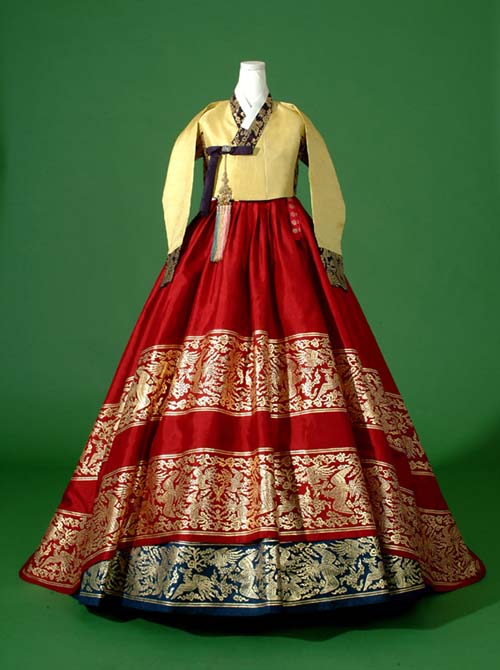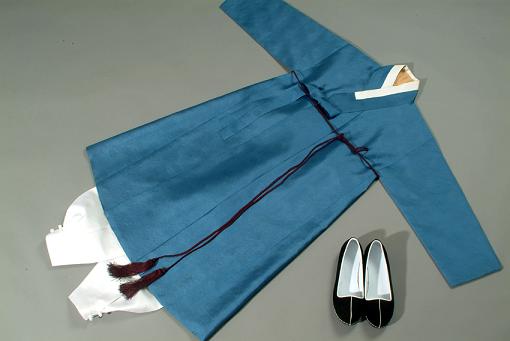
Hanbok 한복) : Traditional dress of Korea...
Amornbyj : Writer
ชุดฮันบก.......
ความงามและเอกลักษณ์ของสุภาพสตรีเกาหลี
ฮัน แปลว่าเกาหลี
บก แปลว่าชุด
เมื่อเอามารวมกันเรียกว่า “ ฮันบก “ แปลว่า ชุดเกาหลี
ฮันบก คือชุดประจำชาติเกาหลี ปัจจุบันไม่นิยมใส่ในชีวิตประจำวัน แต่ก็ยังพอมีเห็นกันบ้างตามชนบทจะเห็นคุณย่าคุณยาย หรือผู้หญิงฐานะดีใส่กัน
จากหนังสือ Look In KOREA
ฮันบก เป็นเครื่องแต่งกายประจำชาติเกาหลีเป็นเวลาหลายพันปี มาแล้ว ความงดงามและวิวัฒนาการทางวัฒนธรรมเกาหลีจะถ่ายทอดสื่อความประณีต และทัศนคติ ของบรรพบุรุษชาวเกาหลี ส่วนหนึ่งในเรื่องการแต่งกายผ่านครื่องแต่งกาย ฮันบกนี้ โดยสตรี
ชุด ฮันบก มีความคล้ายคลึงกับชุดไทยของเรา ในเรื่องของการมีวิวัฒนาการมาโดยตลอดตามยุคสมัย จนกระทั่งในสมัยปัจจุบัน ก็มีชุด ฮันบก ประยุกต์ จากที่ได้เห็นกัน ในละครหรือหนัง พีเรียด ของเกาหลีหลายๆเรื่อง
หากติดตามละครประวัติศาสตร์ของเกาหลี ก็จะเห็น วิวัฒนาการของชุด ฮันบกนี้ จาก ภาพยนตร์เมื่อหลายปีก่อน คือ ตำนานรักทะเลสาบพันปี ที่เอ่ยถึงอาณาจักรชิลลาโบราณ และที่สำคัญ ในปี 2003 คือภาพยนตร์เรื่อง Untold Scandal อันเป็นเรื่องอื้อฉาวในราชวงศ์โซซอน
คาสโนว่าเจ้าสำราญยุคโซซอน ที่ขวัญใจของพวกเรา คุณ เบ ยองจุน นั่นเองที่รับบทบาทเป็น โชวอน ติดหนวด เกล้าผม สวมหมวกทรงสูง เป็นเรื่องแรก
ซึ่งภาพยนตร์เรื่องนี้ เน้น เรื่องเครื่องแต่งกาย และวัฒนธรรม ของโซซอนมากกว่าภาพยนตร์เรื่องอื่นๆ
หลังจากนั้น ก็มาถึงละครประวัติศาสตร์ ที่เดินเรียงแถวมามากมาย ทั้ง
จูมง มหาบุรุษกู้บัลลังก์ ซึ่งเป็นการเริ่มต้นสร้างอาณาจักร โคคุเรียว เป็นยุคสมัยต่อเนื่อง มาจากอาณาจักร พูยอ
ตำนานจอมกษัตริย์เทพสวรรค์ ของกษัตริย์กวางแกโตมหาราช กษัตริย์พระองค์ที่ 19 ของโคคุเรียว
จนมาถึง ความรักของกษัตริย์ คิงมู กษัตริย์พระองค์ที่ 30 ของแพคเจ กับเจ้าหญิงซัลวา เจ้าหญิงแห่งอาณาจักรศัตรู คือชิลลา ที่แม้จะสมหวังที่ฝันฝ่าอุปสรรคกันมาได้ แต่ ก็จบด้วยด้วยการ สิ้นพระชมม์ของเจ้าหญิงที่มีพระชนม์สั้นมาก
แล้วก็ เรื่องที่โด่งดังไปทั่ว แดจังกึม ใน ยุคกษัตริย์ Junjong กษัตริย์พระองค์ที่ 11 แห่งราชวงศ์โซซอน
แล้วก็มีเรื่องของราชวงศ์โซซอน ตามมาอีกหลายเรื่อง ทั้ง ยุคของ กษัตริย์ Seongjong พระองค์ที่ 9 และ และกษัตริย์ จองโจ หรือYi-San พระองค์ที่ 22 แห่งราชวงศ์ โซซอน ( ไม่ได้เรียงลำดับ ตามปีที่การถ่ายทำ)
เราจะเห็น ฮันบก ที่หลากหลายไปตาม ศักดินา และชนชั้น ของผู้สวมใส่ ทุกยุคทุกสมัย
ชุด ฮันบก ที่ดูจะคุ้นตา คนรุ่นเรา ในศตวรรษนี้ ก็ น่าจะเป็น ฮันบก ใน สมัยราชวงศ์ โซซอน นี่แหละ
ผู้เขียน ได้รู้จัก ชุดเกาหลีครั้งแรก ในปีที่ประเทศไทย เป็นเจ้าภาพ กีฬาเอเชี่ยนเกมส์ น่าจะครั้งแรก เมื่อนานมากมาแล้ว เพราะ มีนางงามหลายท่าน ใส่ชุดประจำชาติต่างๆ เป็นผู้ถือป้าย ประเทศเหล่านั้น ในคราวนั้น มีคุณอาภัสรา หงสกุล สวมชุดประจำชาติเกาหลี ก็เป็น ฮันบก ในยุคราชวงศ์ โซซอน นี่เอง
ชุดประจำชาติ สตรีไทย ก็มีวิวัฒนาการ มาตามยุคสมัยของราชธานี ตั้งแต่สุโขทัย ไล่มา จนรัตนโกสินทร์ ซึ่งเฉพาะ กรุงรัตนโกสินทร์ ก็มีหลายรูปแบบเช่นกัน แค่ชุดไทยพระราชนิยมก็หลายแบบแล้ว หลายรัชกาล คุณร้อยตะวัน คงมีข้อมูล ชุดประจำชาติไทยมาเล่าต่อนะคะ
ชุดฮันบก มองดูหนาและมีหลายชั้น ไม่ใช่เพราะอากาศหนาวอย่างเดียว เป็นเพราะชาวเกาหลีเองมีทัศนะคติคล้ายๆจีน ที่ว่า ผู้หญิงไม่ควรเปิดเผยผิวให้คนอื่นเห็นมากเกินจำเป็น ชุด ฮันบก ก็เลยมีประมาณ 4-5 ชั้น สีสันของชุด ถ้าเป็นชุดของเด็กๆ สีสันจะยิ่งสดใส ทั้งที่ชุด ฮันบก ของผู้ใหญ่ ก็สีสันสดใสอยู่แล้ว
คงพอนึกชุดชั้นในสุดของเสื้อใน และกางเกงใน ได้นะคะ ทุกครั้งที่เห็น ก็เป็นสีขาว (เช่นของพระชายากษัตริย์ ฮองลิม และ แม่นางซุก รวมทั้ง โซ อ็อก หญิงสาววัย 16 ที่กำลังจะมาเป็นภรรยาน้อย สามีแม่นางโช ใน Untold scandal ที่เสียท่าให้ โชวอน ไง)
ชุดฮันบก มีเสื้อกับกระโปรงบางๆใส่เป็นซับในชั้นแรกก่อน มีสุ่มไก่ เพื่อให้กระโปรงท่อนล่างบานขึ้นมา ใส่เสื้อบางๆทับอีกชั้น แล้วถึงจะใส่เสื้อและกระโปรงสีสันสดในอย่างที่เห็นกัน (ถ้าจะออกนอกบ้าน ต้องสวมเสื้อนอกอีกตัวหนึ่งทับไว้ด้วย ( แม่นาง ซุก จะสวมเสื้อนอก เวลาออกนอกบ้านหลายครั้ง รวมทั้งมเหสียุน มเหสีองค์ที่2 ของกษัตริย์ Seongjong เวลาออกนอกพระราชวัง )
ชุดฮันบก ประกอบไปด้วย
ชอ โก รี คือเสื้อนอกท่อนบนของผู้หญิงที่มีความยาวระดับอก แขนยาวถึงข้อมือ ในสมัยก่อน
ชอ โก รีมีความยาวถึงประมาณเอว แต่เมื่อเวลาผ่านไป ชอโกรีก็ค่อยๆสั้นขึ้น จากเอวมาที่อก จนกระทั่งขึ้นไปเหนือหน้าอก และมีการปัก รอบคอของ ชอ โก รี และปลายแขน สวยงาม
โครึม ที่ชอ โกรี
โค รึม จะมีเส้นสั้นและเส้นยาว การผูก โครีม จะไม่ผูก เป็นโบว์ แบบบ้านเรา เขามีแบบฉบับการสอด โครีม ที่ไม่ใช่ผูกโบว์
ซี มา เป็นกระโปรงของผู้หญิงที่ปกปิดร่างกายต่อจากชอโกรี มีความยาวคลุมถึงข้อเท้า
ซก ซี มา เป็นกระโปรงชั้นในสำหรับผู้หญิง ใส่ไว้ชั้นในสุด
เหมือน ชุดซับใน ทั้งเสื้อและกระโปรง( บางทีกระโปรง ก็เป็นสุ่มไก่ติดกับเสื้อซับในเลย ไม่ได้แยกเป็นอีกชิ้น)
ทู รู มา กี เป็นเสื้อนอกขนาดยาวเลยเข่า มีทั้งผู้หญิงและผู้ชาย ใส่เมื่อออกไปข้างนอกหรือเพื่อสร้างความอบอุ่นในหน้าหนาวและถ้าเป็นขุนนางหรือชนชั้นสูงศักดิ์ก็จะใส่ไว้ตลอด
ผ้าที่นำมาใช้ตัดชุดฮันบกมีอยู่มากมายหลายชนิดด้วยกัน ไม่ว่าจะเป็น ผ้าป่าน ผ้าฝ้ายมัส ลิน ผ้าไหม ผ้าแพร
โดยผู้สวมใส่จะเลือกใส่ชุดที่ตัดจากผ้าชนิดใดขึ้นอยู่กับสภาพภูมิอากาศ
ฮันบกที่ใช้สำหรับแต่งกายในฤดูหนาวมักใช้ผ้าที่ทอจากฝ้าย
การสวมชุด ฮันบก จะให้สมบูรณ์จริงๆ ต้องมีการเกล้าผมขึ้น เมื่อเกล้าผม ก็ต้องมีปิ่นปักผมและใส่รองเท้าให้เข้าคู่กันด้วย เมื่อสวมรองเท้า ก็ต้องมีถุงเท้า และความสวยงามพิถีพิถันก็เป็นไปตามศักดินาและผู้สวมใส่ อีกตามเคย
ก่อนที่วัฒนธรรมการแต่งกายแบบตะวันตกจะได้เข้ามาในเกาหลีเมื่อ ร้อยปีมาแล้วนั้น สตรีชาวเกาหลีจะสวมชุดฮันบกเป็นปกติทุกวัน
ในปัจจุบันชุดประจำชาติ ฮันบก จะใช้สวมในโอกาสพิเศษต่างๆ งานมงคลสมรส วัน ซอลลัล ( วันขึ้นปีใหม่ ตามจันทรคติ) หรือวัน ซูซก (วันขอบคุณพระเจ้า)
Dangui(당의): Female's royal court
วันที่มีพิธีการพิเศษต่างๆ เช่น วันรับเครื่องราชอิสริยาภรณ์ ที่ยง จุน เคยรับ เครื่องราชฯ นี้
วันที่ ยงจุนทำพิธีเปิดร้าน โกชิเร เมื่อสองปีก่อนที่ญี่ปุ่น
สุภาพสตรี ในวันนั้น ก็สวมชุด ประจำชาติ ฮันบกนี้
ข้อดีของชุดฮันบก ในความรู้สึกของผู้เขียน คือเป็นชุดที่สวมใส่แล้ว มองไม่เห็นทรวดทรงองค์เอวของผู้สวม จะอ้วนหรือผอม ใส่ชุดฮันบกแล้วดูพองๆ กลม เหมือนกันหมด ไม่มีใคร หุ่นดีกว่าใคร แม้ชุดตัวนอก จะบางใสมาก แต่ ไม่รบกวนกิเลศ เพศตรงข้าม

Hanbok ;
The beautiful Korean hanbok is an indelible symbol of Korea. Hanbok literally means “Korean clothing”. It is usually characterized by simple, elegant lines without pockets and bright, vibrant colors. The styles seen today are based on the Joseon Dynasty-style formal or semi-formal wear worn in traditional celebrations or festivals. Women’s hanbok consists of the jeogori or chogori – the short jacket – and the chima – the long, wrap-around skirt. The men’s hanbok consists of a longer jeogori and baggy baji or pants. The inherent beauty of the hanbok is the abundance of material – they are not meant to be tight fitting. Curves or curved features are important in traditional design of the hanbok.
Original ;
It is theorised dangui dates back to the Korean Three Kingdoms period (57 BC - 668 AD) when a clothing system of China was introduced to Korea. The letter, dang (唐) refers to Chinese Tang Dynasty (618 – 907), so dangui may have been adapted from its clothing along with other ceremonial robes such as hwarot and wonsam. Whether the theory is probable or not, it is certain that dangui was worn during the Joseon period, based on historical documents and remains. The scholar, Yi Jae (李縡 1680 ∼ 1746) mentioned dangui in his book, Sarye pyeollam (literally "Easy Manual of the Four Rites) which defines four important rites based on Confucianism. In the chapter, Gwallyejo (冠禮條) on coming-of-age ceremonies, samja (衫子) is commonly called dangui and its length reaches to the knees and its sleeves are narrow. It is also a woman's sangbok (常服), daily garments when working
Dangui Features ;
The queen consort, the king’s concubines, sanggung (court matron), and yangban women (nobility) wore the garment over a short jacket called jeogori. According to color, there were yellowish green, purple, navy, and white-colored dangui and others, but yellowish green colored one was the most commonly worn dangui during the time.[2]
In addition, dangui can be divided into two types depending on its layer; a double layered dangui (gyeop-dangui 겹당의), and a single layered one (hot-dangui, 홑당의). The former was usually worn during winter while the single layered dangui which is also called dang-jeoksam or dang-hansam was worn for summer. As the Queen wore a white dangui made of a single fabric the day before the Dano festival which falls on the 5th day of the fifth month of the lunar calendar, every women at court followed to change their clothing to the single layered one the next day. Likewise, when the Queen began to wear a double layered dangui the day before Chuseok which celebrates on every 15th day of August in the lunar calendar, all women in the palace changed their clothing to the double layered dangui the next day.[2][6]
The characteristics of dangui is to emphasize the beauty of hanbok’s curvy lines. The form of dangui is similar to that of jeogori, the length of both the front and back which reach to the knees is triple to that of jeogori. Sleeves of dangui are narrow. The side seams are open to the armpit, and the hem is curved. When making a dangui with a yellowish green fabric, the color for the inner fabric and for goreum (고름, ribbons at chest) is red and purple respectively. Two goreum are attached at the left side of git (깃), a fabric band of that trims the collar while one short goreum is at the git’s right side. At the end of the sleeves of dangui is geodeulji, a kind of white patch attached.[2]

The dangui for women at court strictly represented the wear’s rank whereas the dangui for commoners was not allowed to have any style used for the former. The dangui for the Queen, princesses or other royalty, geumbak (gold leaf) patterns were decorated from the shoulder part through the end of the sleeves, as well as the front and back side, and goreum. In geumbak patterns, flower or bat illustrations or Chinese characters referring to longevity (su, 壽) , fortune (bok , 福), or double happiness (hui, 囍) were used. For the Queen, phoenix patterns were used. When dangui was worn as a wedding dress, the bride wore it over a chima (a wrapping skirt) and jeogori. The wearer also put a hwagwan (a coronet) on the head, attached a norigae (노리개), a type of accessory to the goreum, and wore a pair of shoes made of silk. It is easy to wear and neat, so dangui was one of commonly worn wedding clothing among commoners during the Joseon Dynasty
Source ;
http://blog.daum.net/_blog/ArticleCateList.do?blogid=06FC8&CATEGORYID=189169&dispkind=B2203#ajax_history_home http://cafe.naver.com/ArticleRead.nhn?clubid=10057504&articleid=10038
http://cafe.naver.com/ArticleRead.nhn?clubid=16478475&articleid=2567
http://en.wikipedia.org/wiki/Dangui
http://beyondjane.com/fashion/style/simple-beauty-the-korean-hanbok/



No comments:
Post a Comment
Note: Only a member of this blog may post a comment.